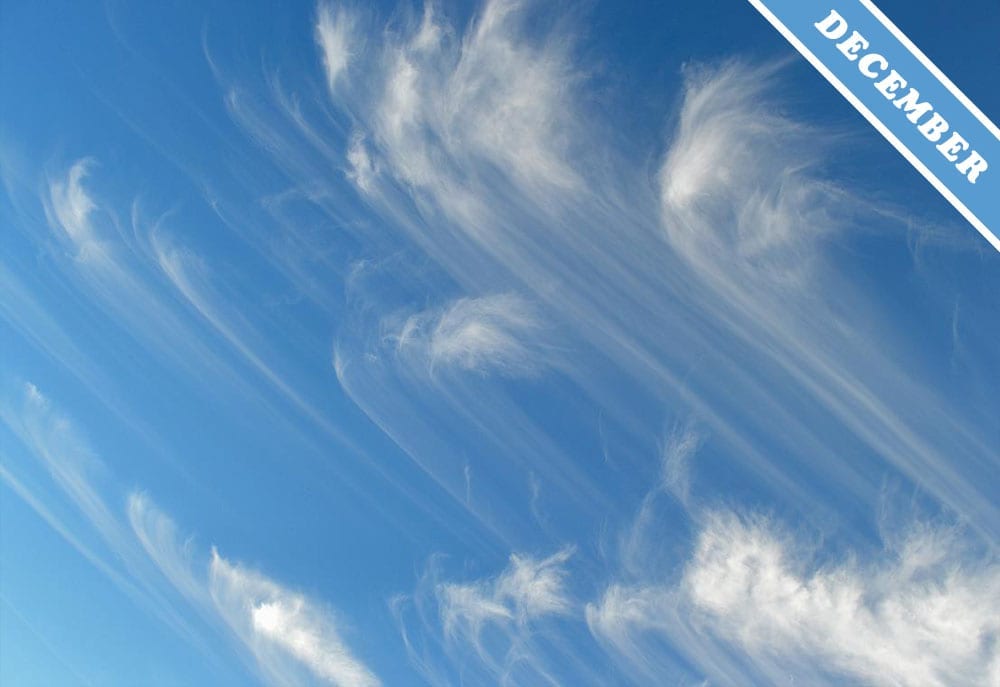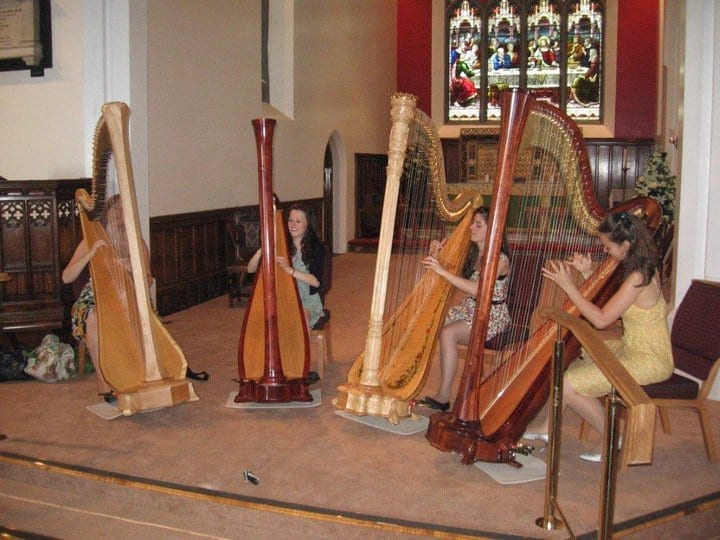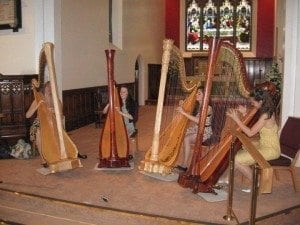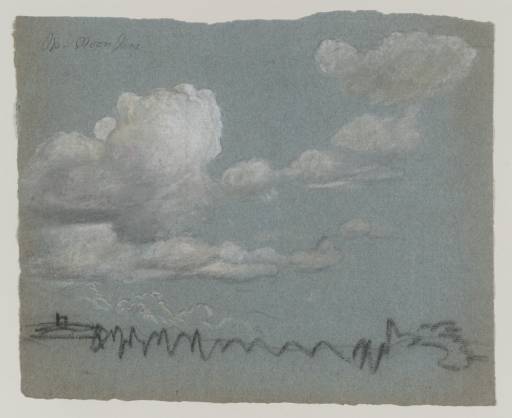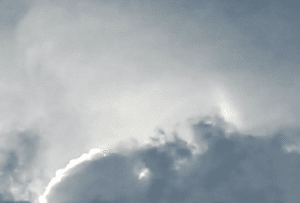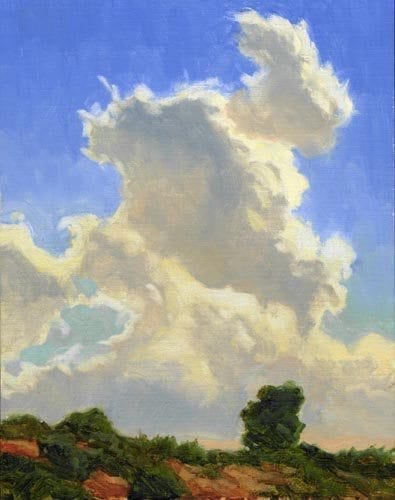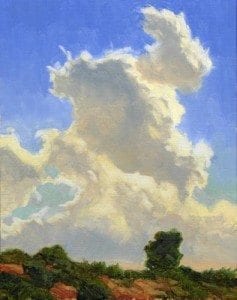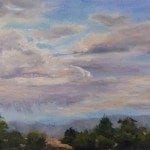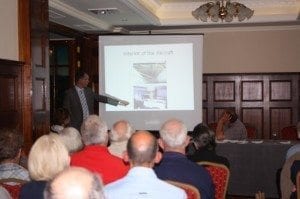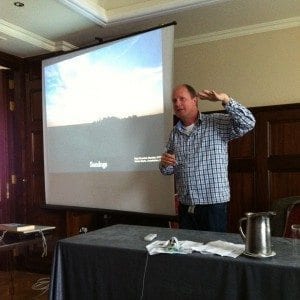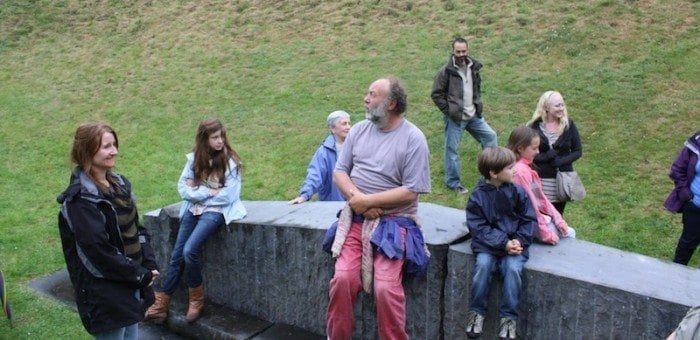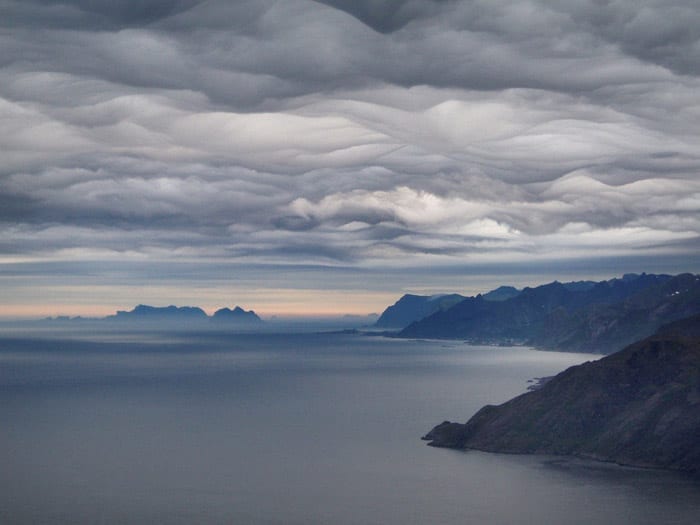Artists Rob and Nick Carter recently contacted us about their latest body of work. It plays on the transient nature of light and form and, they say, also creates a dialogue about the ephermeral aspect of art. The Carters have created their own coloured clouds which continues their preoccupation with light and colour and is achieved by a unique action photography that captures paint pigment spontaneously thrown into the air, juxtaposed against the blue sky as if it were dancing in space.
Category: Attention All Cloudspotters
You can’t look around when you’re looking up, so we’ve had a look around for you.
If you have cloud news that you think we should include here, please email it to us at: hello@cloudappreciationsociety.org.
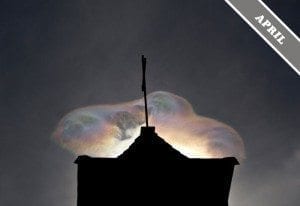
It’s a beautiful example of ‘cloud iridescence’ and you can see it here:
April’s Cloud of the Month…
This was spotted on the National Geographic Daily News website with a story entitled “NASA Rockets Make Weird Clouds Near Edge of Space”.
The effect is caused as chemicals react with water and oxygen in the atmosphere to create the milky white clouds and were visible to both scientists and public in the clear morning skies along the US Northeast coast.
Amanda Murphy discovered this LP whilst at work. It is by British songwriter Graham de Wilde and is aptly named ‘Clouds’
We haven’t heard it and it’s currently out of print but maybe one to look out for. If you have a copy why not leave a comment and let us know what you think?
But for members of the Cloud Appreciation Society, naming these familiar high clouds is a doddle. You can see the answer at the bottom of Storm’s piece. But how many know the name of the optical effects that appear as spots of light on either side of the base of the photograph, and are caused by the sunlight passing through the ice crystals of the clouds (answer here)?
Cloud Appreciation Society member, Peter Kaiser from Vienna sent us this link to stunning indoor clouds that were created by artist Berndnaut Smilde. He uses smoke machines combined with lighting and interior atmospheric conditions along with meticulous experimentation to create these results. He told Gizmag “I wanted to make the image of a typical Dutch raincloud inside a space”.
Musician Brian Spence released his new album On the Mend on January 3rd 2012. We think that the cover photograpy is spectacular. It is an image of crepuscular rays and was taken by Angela Craggs.
Buy ‘A Fantasia for Clouds’ from The Cloud Shop…

Unfortunately, Gavin won't be wearing his 'cloud 9' outfit, complete with fake legs. Sadly, it fell apart after he wore it at a previous talk.
Gavin would love to say hello to any cloudspotters who happen to be in the area and free to come along on Wednesday afternoon.
Cloudspotting by Gavin Pretor-Pinney
Wednesday 7 March, 5.15pm
Theatre By The Lake, Lakeside, Keswick, Cumbria, CA12 5DJ.
Ticket price: £7.50
Box Office: 017687 74411
Or go to the Theatre By The Lake website and scroll down to find the talk under “Gavin Pretor-Pinney” to buy a ticket online.
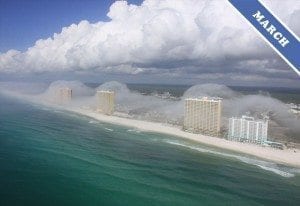 A stunning fog formation on the coast of Florida, US, is our Cloud of the Month for March. This dramatic wave effect made media headlines around the world. Well done to photographer, J.R. Hott, for capturing such a rare and beautiful formation.
A stunning fog formation on the coast of Florida, US, is our Cloud of the Month for March. This dramatic wave effect made media headlines around the world. Well done to photographer, J.R. Hott, for capturing such a rare and beautiful formation.
You can see the March Cloud of the Month here.
Diana Willcox, Secretary of the Macclesfield Astronimical Society has asked us to let you know about an upcoming talk on Red Sprites. It will take place on Tuesday, April 3rd 2012 at 20.00 at Hulley’s, Astrozeneca in Macclesfield.
The speaker, Peter McLeish. is a multimedia artist, filmmaker and painter from Montreal. He has been involved in collaboration (based on Red Sprites) with American Scientist Walter A Lyons. Peter’s lecture will include a video presentation and footage of this startling phenomenon.
If you would like to attend this talk you should visit the Macclesfield Astronimical Society website to reserve a ticket and find directions.
Tom Benjamin currently has a solo exhibition running at the St Anne’s Gallery in Lewes called “In the Service of Clouds”. Alex Leith of Viva Lewes Magazine says “He’s a great painter, in the impressionist mode, who does all his paintings au naturel. He has developed a style whereby he kneels down to paint so as to get a snail’s eye view of the sky”.
The show started on 25th February and is running until 4th March. You can visit Tom Benjamin’s or the St Anne’s Gallery website for more details.

firstsite is a contemporary art gallery in Colchester. Jes Fernie, Associate Curator of the gallery recently contacted us about their current exhibition, Equivalents. The exhibition, selected by the artist Steven Claydon, contains a series of cloud studies painted by Constable during the 1820s.
Cloud Appreciation Society founder, Gavin Pretor-Pinney, will also be coming to firstsite to give a talk about clouds referring to Constable’s studies on 3 March 2012.
The exhibition runs from 4 February to 7 May at firstsite, Colchester, UK.
“Prior to my accepting the job over here, breaking away from my old job, I was divided and in two minds as to what to do. I consulted one of my dearest friends whom I have known since we were both children and who completed a ski season last year in Meribel in the 3 Valleys. He told me that I had to go, and that I would not regret it. One week later he died under incredibly tragic circumstances, (for details please see the following link about the inquest a few days ago into his death) leaving a gap in the universe that will never again be filled and, in my opinion and that of others, leaving the world a far worse off place. As far as I was concerned I no longer had a choice, I had to go.
“Five weeks into my season, I was still in an incredibly fragile state, I still am now. However, I had been doing quite well at just getting on with it, telling myself that he’d kick my arse if he saw me moping all the time. Despite my efforts though, I did find myself being overcome with emotion from time to time. One such occasion I was sitting in one of the cafes on the slopes taking a break after boarding for 3 hours on my own. I was tired which didn’t help and I was depressed because I really just wanted one person who I could go out with and learn from. I kept on thinking about how different it would be if he was there, if he was with me. I found water to be welling up in my eyes so I looked up to the sky in the hope that if anyone saw me they would just assume that it was the sun in my eyes that was making them water. Attached you will find a photo of what I saw, I took two pictures just to make sure I wasn’t tripping or anything. Then, at the exact moment that I saw it, the music in the cafe changed to Pink Floyd, ‘Wish You Were Here’. Now I am generally quite a scientifically minded person, but that day I am convinced that he spoke to me. And even if it was all coincidence, I still found myself getting back on my board and riding like mad for the rest of the day.”
Emily’s story touched a chord with us. It made us think of the 1913 poem, ‘Clouds’, by the British war poet, Rupert Brooks:
They say that the Dead die not, but remain
Near to the rich heirs of their grief and mirth.
I think they ride the calm mid-heaven, as these,
In wise majestic melancholy train,
And watch the moon, and the still-raging seas,
And men, coming and going on the earth.
Read Emily’s blog here.
See Emily’s photograph of a heart on the society photo gallery.
Cloud Appreciation Society member, H Brown, recently sent us the link to the Met Office publication “Cloud Types for Observers”. This is an extremely good classification source and will be interesting for all cloud enthusiasts.
It can be found on the Met Office website here.
 Our mugs are just back from the printers and they are great. Now you know what to drink your tea from when you are out cloudspotting in the garden.
Our mugs are just back from the printers and they are great. Now you know what to drink your tea from when you are out cloudspotting in the garden.
Go to the Cloud Shop to see our Cloud Appreciation Society mugs here.
 We know how all you cloudspotters out there are reluctant to do the washing up because you don’t have tea towels to be proud of. We know what problems this can cause with your friends and partners. Well now that particular impediment to family harmony is no longer. We are proud to introduce in our Cloud Shop none other than the glorious new Cloud Appreciation Society tea towels…
We know how all you cloudspotters out there are reluctant to do the washing up because you don’t have tea towels to be proud of. We know what problems this can cause with your friends and partners. Well now that particular impediment to family harmony is no longer. We are proud to introduce in our Cloud Shop none other than the glorious new Cloud Appreciation Society tea towels…
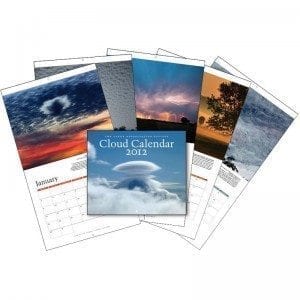 We’ve got a few left of society’s Cloud Calendar, 2012. So, in the long tradition of February calendar discounts, we now have them on sale at half price: just £4.99 each (+ postage/shipping).
We’ve got a few left of society’s Cloud Calendar, 2012. So, in the long tradition of February calendar discounts, we now have them on sale at half price: just £4.99 each (+ postage/shipping).
Each month of the Cloud Calendar features a stunning cloudscape photographed by a member of the Cloud Appreciation Society, selected from the many thousands on our photo gallery. For each image, there is a brief account by the member of what inspired them take the photograph and, at the back of the calendar, a spread gives descriptions and explanations of the cloud formations featured.
You can buy the discounted calendar in our cloud shop.
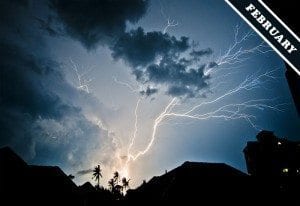 Mike Sharp’s image of lightning over Penang, Malaysia is a beauty, and so receives the highest honour of cloud photographs sent in to us during the past month: it becomes February’s Cloud of The Month.
Mike Sharp’s image of lightning over Penang, Malaysia is a beauty, and so receives the highest honour of cloud photographs sent in to us during the past month: it becomes February’s Cloud of The Month.
Landscape Treks are a small company who guide people to wild locations in the UK’s mountains to experience superb scenery, capture stunning images and above all, enjoy being in the great outdoors.
If you would like to join one of their treks specifically to enjoy being guided to some remote locations and enjoy some cloud watching please contact them via their website.
Barbara Felicetti of Ardmore, PA recently drew our attention to this article on the New Scientist website by their CultureLab editor, Kate Austen who was lucky enough to visit the experimental sci-art gallery “Le Laboratoire” in Paris to view these beautiful crocheted cumulus clouds.
“Lit from within and above, the swathes of crocheted white wool hang from the ceiling to just half a metre above the ground, casting familiar shadows on the gallery floor. The fluffy cashmilon wool chosen by the artist, Argentinean architect Ciro Najle, works well for cumulus clouds – the puffy ones that can precede thunder storms, and are precursors to the godfather of clouds, the cumulonimbus” she says.
You can read the full New Scientist article here and see details of the exhibition here.
Cloud enthusiast HelmutVölter recently contacted us about an exhibition he curated for The Fotomuseum Winterthur in Switzerland entitled “Cloud Studies – The Sicentific View of the Sky”. The exhibition is currently running until 12th February 2012.
The exhibition contains a range of original cloud photographs that have been produced and used in many different ways. There are cloud atlases (the first International Cloud Atlas from 1896), cloud photo albums, single photogrpahs, hand books, press photographs, magazines and films. The Japanese physicist, Masanae Abe observed and filmed the clouds around Mt Fuji in the 1930’s.
You can see more about the exibition here.
…and it’s a beauty. Not only does Ryan Verwest’s photograph show one of our favourite cloud types, the lenticularis cloud, it also shows the beautiful rainbow colours that can result from the sunlight passing through a cloud’s edges. Not all clouds have silver linings. Some have multi-coloured ones.
See the January Cloud of the Month here.
Frequent visitors to the society Cloud Gallery will be familiar with the beautiful and dramatic ‘Kelvin-Helmholtz clouds’, which look like a series of breaking waves and often appear in a line of beautiful vortices. Normally, these formations are spotted amongst mid-level or high clouds, and so are only noticed by cloudspotters who make a point of looking up. We made Kelvin-Helmholtz wave clouds worth 55 ‘cloud-collecting points’ in our reference book The Cloud Collector’s Handbook, in which you get point for the different clouds you spot (UK version of the book is here, US version is here). This is the highest points of all the clouds types in the book, since it is rare and fleeting formation that is easy to miss.
But not all examples of Kelvin-Helmholtz clouds are this elusive. Some recently appeared in the skies over Birmingham, Alabama, US, which no one could have missed. These wave clouds were so low in the sky, and had such prominent breaking-wave shapes that they stunned locals. The dramatic waves soon flooded the media, newspapers and Internet. They became known as the ‘Alabama tsunami clouds’.
The world may have been stunned that breaking waves can appear within the clouds like this but bit members of the Cloud Appreciation Society. They have been sending in their amazing and beautiful Kelvin-Helmholtz cloud photographs for years.
We would like to wish a very Merry Christmas to all our members – both old and new. And to get you in the mood, we’ve picked out a few festive clouds that look things from the society photography gallery:
The Cloud of the Month for December is some fancy Cirrus clouds spotted over South Carolina, US, and photographed by Betty Owen. You can see previous Clouds of The Month here. (Please bear with us when it comes to some of the older entries, as we are still updating the layouts).
They recently completed their first UK tour to promote this, their debut CD, and will be playing at the Bridgewater Hall, Manchester on the 13th and 14th December. Details can be found here.
You can also hear one of the movements from the cloud piece on their website http://www.soundcloud.com/estherswift
She goes on to explain that the exhibition contains “exquisite chalk sketches by Thomas Kerrich and Down [she wasn’t sure of the name of this artist] dating from before cloud classification, a notebook illustrating techniques for shading in clouds, wonderful Constables (of course) and Turner sketchbooks”. Littered throughout the exhibition are all the amazing Turner cloudscapes that The Tate possesses and, it seems, much more besides.
The exhibition is free. Here are the details and a link to the (minimal) information about it on the Tate website:
Romantics
9 August 2010 – 3 June 2012
(Free entry)
Tate Britain, Millbank, London SW1P 4RG
http://www.tate.org.uk/britain/exhibitions/romantics/default.shtm
Several members have alerted us to a growing number of amateur videos recording strange shifting light effects appearing above Cumulonimbus storm clouds. These dancing patches of brightness appear to be caused by the cloud’s charged water particles moving around in response to shifting electric fields as lightning strikes within the cloud below.
Different theories about the exact cause of these effects have been going around the Internet. A NASA website reports the hypothesis that these effects are when ‘a lightning discharge can cause a sundog to jump’. By ‘sundog’, they are referring to the ice-crystal optical effect also known as a ‘mock sun’ or ‘parhelium’. Here is what NASA’s Astronomy Picture of the Day website said:
http://apod.nasa.gov/apod/ap111108.html
Les took issue with the NASA website explanation, claiming that it is very unlikely these effects are caused the sort of ice crystals that produce sundogs. You just don’t tend to find the right type of ice crystal at the top of Cumulonimbus storm clouds. But if they aren’t moving sundogs, when what are they? “We do not really know what is happening,” Les admitted. “We need more hard evidence, more measurements and cloud-physics modelling before we can hope to come up with a clear explanation. At the moment, we are nowhere near that position.”
If scientists need more examples, then surely us cloudspotters are the ones to help. We may not be able to provide physical measurements, but we can surely come up with a few more YouTube vids, can’t we? Anyone who manages to capture another video of one of these beautiful and mysterious dancing storm-cloud light effects can submit it for inclusion on our ever-expanding Cloud Videos page. The first to send a new on in will win a special society prize in recognition of their efforts to help reveal the mysteries of Cumulonimbus, the King of Clouds.Chiara Frugoni, a cloudspotting art historian in Assisi, Italy, has discovered a cloud shaped like the face of the devil that was painted 170 years before Mantegna’s cloud look-a-like. Frugoni spotted the depiction of the horned face hidden in one of the frescos by Giotto in the Basilica of St. Francis of Assisi. Frugoni has been researching the frescos for the past 30 years, and believes that Giotto’s cloud face was painted in 1289.
In the 720 years since then, thousands upon thousands of pilgrims, tourists and scholars have gazed up and admired the paintings but it seems that no one has noticed the face until now. Though it is hidden within the Cumulus clouds near to an angel, Frugoni claims that “it is very visible” once you notice it. So why hadn’t anyone else noticed Giotto’s cloudy secret for all that time? “One sees what you already know,” said Frugoni. “I assure you that now all will see it.”
We are delighted to have heard of this momentous cloudspotting discovery (and grateful to Antonio Lazzarin of Milan, Italy for drawing our attention to it). Our only disappointment is that Chiara Frugoni didn’t reveal Giotto’s 720-year-old secret just a few weeks earlier. If we’d heard about it then, we’d have been able to mention it in the introduction of our new book before it went off to the printers. ‘Clouds That Look Like Things’ is a going to be a fantastic collection of cloud look-a-likes photographed by members of the society, which will be out in the UK in April 2012. It doesn’t contain a photograph of a cloud in the shape of a Devil’s face. But who needs the Devil, when we’ve got a pretty good likeness of Jesus?

Our new shop system should be easier to use, and paves the way to a single site-wide login for members
We have been working away behind the scenes to set up a new shop system. It now fits in with the look of the rest of the site and, more importantly, is should be easier to use.
There is one drawback in changing over to a new system: people will have to enter their address details as a new customer the first time that they use the new shop. We hope this won’t be too much of a bore, but customers can always buy products without setting up an account. As before, the payments are all obviously handled on an independent and completely secure payment server.
Another advantage of this new shop system is to do with logging in. In the future, we want to set things up so that members can log into the website and get access to pages that normal visitors can’t see. The new shop will be integrated with this, which means that as a member you only need to log in once to access member pages and have your delivery details available in the shop. If you are a member, please tick the box to say so when you log in for the first time. If you can find your membership number you can enter this to help ensure that, when the time comes, you’ll already have a log-in for accessing member-only pages of the website.

If you are a member, please tick the box when you first log in and (if possible) give your member number
Please do tell us here whether or not you find the new shop system works OK for you. No doubt there will be a few teething issues, as there were when we changed over to the new Cloud Photo Gallery, but we hope it will make life easier in the long run.
Needless to say, our shop has all sort of fantastic society merchandise on it. We are especially proud of our cloud calendar and new greetings cards:

Fellow cloud lover, Kath Hortic has sent us the link to a recently published article on OS Maps Magazine website.
It’s a very informative and interesting piece which includes a video showing different cloud types. You can read it here.
Tom Blazier, Member No. 17,468, got in touch to tell us about the Cloud Appreciation Day that he helped organise on 6 August 2011 for his landscape painting society, the Plein Air Painters of New Mexico.
New Mexico is known for its dramatic skies – especially during the summer monsoon when magnificent cumulus buildups are a daily event. PAPNM designated the first Saturday of August Cloud Appreciation Day as a day for its members to celebrate the beauty of clouds by painting directly in the open air rather than in the studio. The paintings are a snapshot of how the sky looked in various locations on the same day as interpreted in each artist’s style.
Participating members painted the sky on August 6 2011 and entered digital photos of their paintings in the contest. Members then voted for their favorite painting from among entries exhibited online. The winning cloudscape was “Ever Changing” (14″ x 11″ oil on board) by Lee MacLeod of Santa Fe. Lee will be awarded with a membership certificate, button and gift from The Cloud Appreciation Society to be presented at the PAPNM annual meeting in December.
Earlier this summer, Sally McKenna (Cloud Appreciation Society Member No. 20,711) organised ‘The First Irish Cloud Festival’ in the West Cork region of Ireland. The idea was conceived in conjunction with Hans Wieland (Member No. 27,412) to bring together Irish cloud lovers and, more specifically, the Irish chapter of the society, known as ‘The Irish Cloud Appreciation Society’.

Gavin Pretor-Pinney experiences James Turrell's crater at the Liss Ard Estate, Skibbereen, during the first ever Irish Cloud Festival. © Harry Reid.
The cloud festival was held in Skibbereen, and proved a great success, with visitors coming from all four corners of the country to listen to talks on cloud-related themes and to do a bit of collective cloud gazing. The cloudspotting part took place in the ‘crater’ made by the Californian artist James Turrell within the grounds of the Liss Ard Estate. This amazing man-made structure acts as a sort of amphitheatre of the sky, the crater rim serving to frame the skyscape above as you lie down and look up from its centre.
Of course, the clouds did not behave as requested. They never do. The day before and the day after were perfect for cloudspotting, but the day of the Cloud Festival itself was veiled in what can only be described as the boring cloud: wall-to-wall Altostratus. No one seemed bothered, however. After all, where would we be if the clouds simply did what we wanted?
Cloud Appreciation Society founder, Gavin Pretor-Pinney, was delighted to be invited over over to West Cork as one of the speakers. He gave a talk entitled ‘Cloudspotting For Beginners’. Amongst the other speakers were Colm Conyngham, who gave a fascinating and harrowing account of when he got closer to a cloud than he ever wants to be again. He had a terrifying ordeal onboard an Air France flight over Africa on a plane that had a faulty weather radar, and as a result flew directly into a Cumulonimbus storm cloud. Though still suffering from memories of the ordeal, which resulted in many injuries amongst the passengers and crew, Colm accepted a Cloud Appreciation Society badge and is working towards wearing it in an effort to put the whole thing behind him. Also speaking were photographer John Baylis Post on how to take successful sky photos, Ian Carruthers, a local storm chaser and John McKenna on the theme of clouds in New Yorker cartoons.There is already talk of organising another Irish Cloud Festival in 2012, perhaps this time in Sligo on the north west coast. Anyone interested in this idea can join the discussion on the Irish Cloud Apprecaition Society Facebook page:
http://www.facebook.com/topic.php?uid=108602662490872&topic=401
A Newstalk Radio report on the first Irish Cloud Festival.
and here:
Download a mp3 podcast of the report on the Irish Cloud Festival by Lyric FM.
If you’ve taken a look at the society’s cloud photo gallery recently, you might have noticed that it has changed. We’ve been working feverishly in the background to update the gallery system and introduce some improvements that we hope you will appreciate. Inevitably, there will be teething problems as the new system beds in, but these are the reasons why we think that the new system is an improvement on the old:
• We have streamlined the system so that the 7,500 or so pictures on our gallery load more quickly.
• It is now much easier to search for specific cloud types. When you click on the Find a Cloud tab at the top of the page, you can select cloud classification terms in the sidebar. By clicking on these tabs, you can narrow your search to very specific types of cloud formation. If you want to unselect a tab, just click it again.
• You can now click on a photographer’s name and see all the images that they’ve got on the gallery.
• When you hover your mouse over an image, forward and back arrows appear at either side. Click these to advance through the found set of images.
• When you click the View Slideshow button at the top of the page, the slideshow plays using the set of photographs that you’ve just found. In this way, you can view a slideshow of photographs from a particular photographer or of a specific type of cloud.
• You can now rate a picture and leave a comment about it by clicking in the middle of the image. This shows it in detail view. (Being able to easily go back from this detail view to where you were is something we are still working on!) In future, we plan to introduce a way of finding the most popular images.
We have tried hard to come up with a system works both for those who want to be able to search for very specific cloud types and those who just want to see pretty pictures of the sky. Thanks to all our fantastic members and visitors who have contributed their photographs, we have what must be the most extensive gallery of cloud photographs in the world. We’d love to hear what you think of the new way of viewing them.
Members and visitors might remember that a couple of years ago we proposed that a new classification of cloud should be added to the official classification system. Photographs of this cloud formation had been sent in by Society members over the years, and we’d never known quite how to classify them since we felt that they didn’t easily fit into the existing cloud terms.
The cloud looks a little like the surface of the sea on a choppy day, which is why we proposed that it should be called asperatus from the Latin verb ‘aspero’, meaning to make rough. The term was used by Roman poets to describe the sea as it was roughened by the cold north wind.
No sooner had we proposed asperatus as a new cloud type than the story ‘went viral’, becoming one of those news stories that just spreads through the world media. News pieces appeared in the UK, the US, online and in many other contries. It was even nominated as one of Time Magazine’s 50 best inventions of 2009.
We felt all this press attention was a little premature as there hadn’t even been time to look into the atmospheric conditions that give rise to the cloud formation. But all the publicity did lead to a huge number of people sending in their own photographs of asperatus clouds they’d spotted, greatly adding to the growing asperatus collection.
Soon, the term was being adopted by cloudspotters around the world. But we always thought it a pretty unlikely to ever be accepted as an official term. This, we were were told by our friends at The Royal Meteorological Society would only happen if it were acknowledged by the World Meteorological Organisation in Geneva, who publish the rather dry but thorough bible of cloud classification, The International Cloud Atlas.
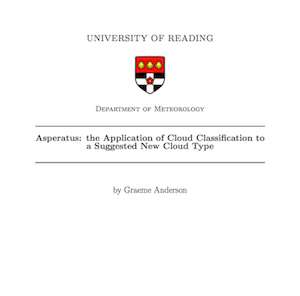
Graeme Anderson's asperatus dissertation.
By studying the weather records and using a computer model to simulate the cloud, Graeme found evidence that asperatus is formed in the sort of conditions that produce mamma clouds (also known as mammatus), but when the winds up at the cloud level cause it to be sheared into wavelike forms known as undulatus. The conclusion was that there was a case for this being accepted as a new classification – one that is called a cloud ‘supplementary feature’.
The Royal Meteorological Society is now encouraging the international meteorological community to update the Cloud Atlas and include asperatus to make it official. The current edition, after all, was published in the 1970s. If asperatus is accepted, it will be the first official cloud classification in 60 years.
The asperatus sightings continue to come in. Just recently, a dramatic display over Chicago, US, featured in the local newspapers (and see an update here).We will keep you posted if there is any news about the World Meteorological Organisation deciding to go ahead and update the classification system.
Members and visitors might have enjoyed the fantastic collection of fallstreak-hole photographs displayed on our photo gallery. Also known as ‘hole-punch clouds’ these formations occur when part of a cloud of water droplets freezes into ice crystals. Scientists have known for some time that the effect occurs when the ice crystals grow large enough to fall below as a fallstreak. But what has always been unclear is quite why the freezing starts in one particular region of a cloud layer and how the hole grows in size, sometimes reaching 50km across an hour after the hole began. Now, research published in Science magazine has helped explain some of the mysteries of these beautiful fallstreak holes.
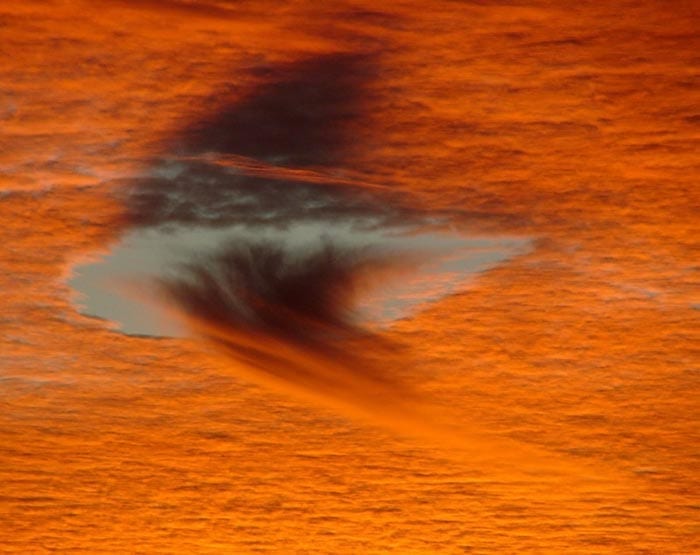
A fallstreak hole at sunset over Jay, Florida, US. © Vicki Harrison.
We already knew that, for the hole to form, the droplets in the cloud layer need to be ‘supercooled’. This means that they are at a temperature below 0˚ Celsius, but have yet to frozen. In fact, cloud droplets can and do often remain liquid at temperatures well below the freezing temperature of a glass of water down here on the ground. When in the form of tiny droplets, water needs a nucleus of some sort to be encouraged to freeze – a tiny particle of some sort that it can get started on. Without one of these icing nuceli present, droplets will resolutely refuse to freeze until the air temperature drops to as low as –40˚ Celsius.
But what gets the freezing started in one region of the cloud? The research has confirmed the long-held suspicion that an aircraft flying through the cloud can be enough to set off the freezing process. The expansion of the air as it passes over the aircraft wings and (for certain types of plane) over the blades of its propellers, causes it to cool. This momentary cooling can be enough to take the temperature down low enough for the droplets to start to freeze spontaneously, even though there aren’t enough icing nuclei around for the droplets elsewhere to freeze.
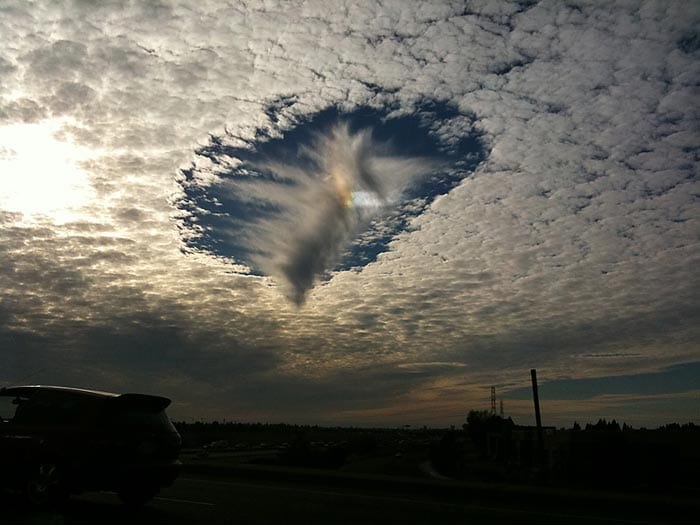
The ice crystals in this fallstreak hole over Sacramento, California, US, are refracting the sunlight to produce an optical effect known as a sun dog. © Danny McNeal.
The research also proposed a way by which the freezing water might cause a hole to expand outwards from the point where the plane flew through the cloud. When the droplets change into solid particles, they give off a tiny bit of heat – enough to cause the air to expand and rise a little. In reaction to this rising current, the surrounding air sinks slightly. As the air around the frozen fallstreak sinks and warms up, the droplets there evaporate. This seems to be the method by which the fallstreak of ice crystals produced by the plane climbing or descending through the cloud layer forms a circular hole that appears punched out of the cloud layer.
If the plane is passing through the cloud at a more shallow angle, it causes a line of cloud to freeze, producing a cigar-shaped hole, somtimes known as a canal cloud (see below). You hear Cloud Appreciation Society founder, Gavin Pretor-Pinney, speaking about this beautiful cloud effect to National Public Radio in the US and you can read more about the new research in New Scientist Magazine.
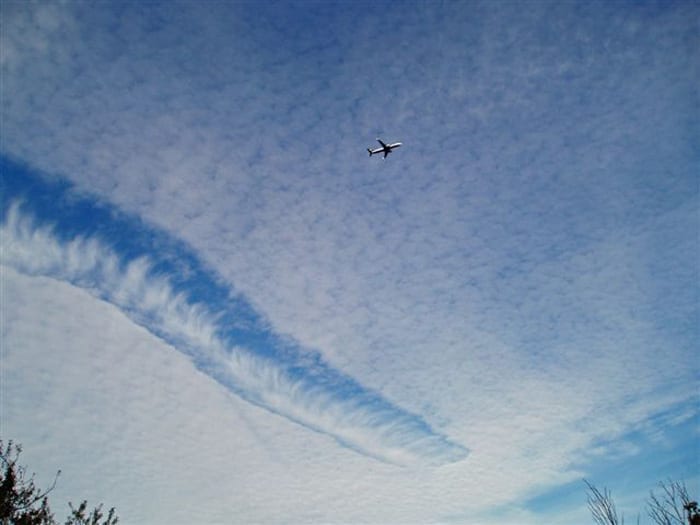
When a plane passes through the cloud layer at a shallow angle, it can cause a line to be cut from the cloud, known as a canal cloud or a distrail (short for dissipation trail). Spotted over Broxted, Essex, UK. © Michael Holt.
Earlier this year, Cloud Appreciation Society founder Gavin Pretor-Pinney was asked to go on a ‘sky walk’ in London’s Hyde Park by students in Product Design at the Royal College of Art. Intrigued by the sound of this, he went along and was handed a pair of strange mirror classes, created by design student Marjan van Aubel. They act like mirrors that reflect an image of the sky into your eyes as you walk around. The sensation of wearing them is rather weird. It feels a little like flying upside down.
Gavin talked to the students about the clouds that they were all enjoying through the reflections of their sky glasses. He commended Marjan on her fantastic invention. Cloudspotters will love them, but they might not catch on amongst the general public. Anyone wearing them as they walked around London would be run over by a bus within about 10 minutes. They also make you look a bit stupid.
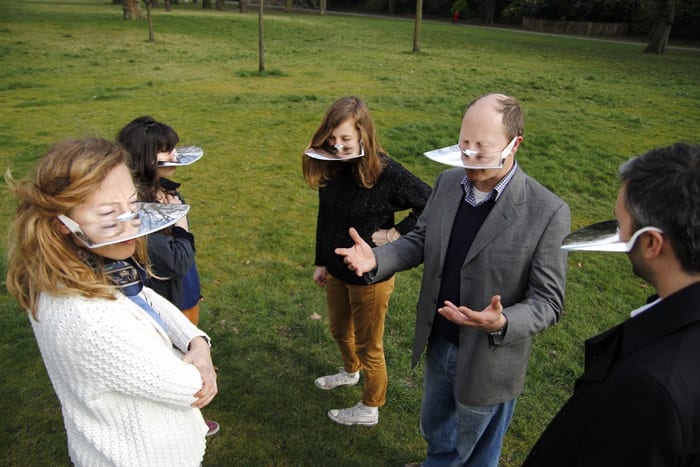
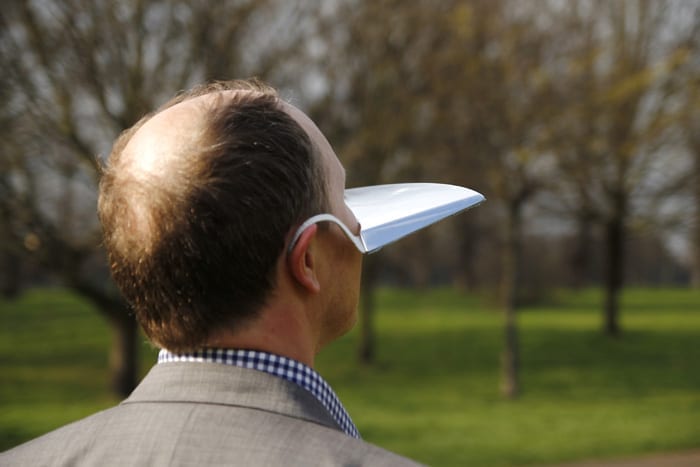
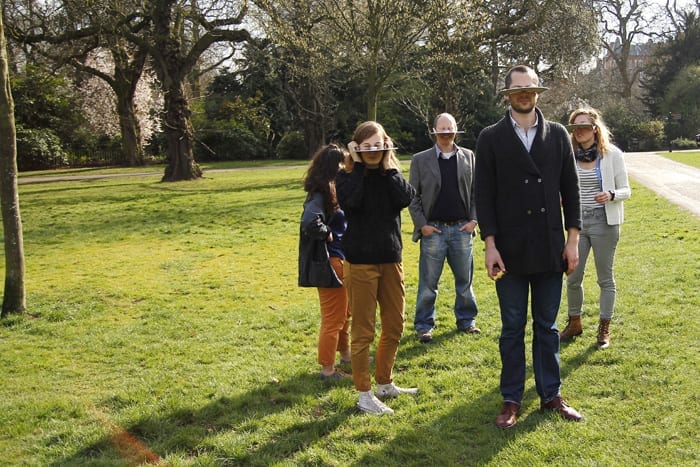
You can see Marjan van Aubel’s work here.
She has no plans to manufacture the sky glasses yet, but I’m sure she’s open to persuasion…
Lorna Stroup Nilsson sent us the link to this cloud inspired dessert. She says “it isn’t terribly easy to get blue Jello (jelly!) in the UK, but I got a pack via Amazon. Anyway, this recipe really does work!”



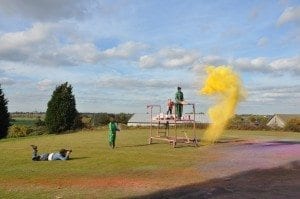
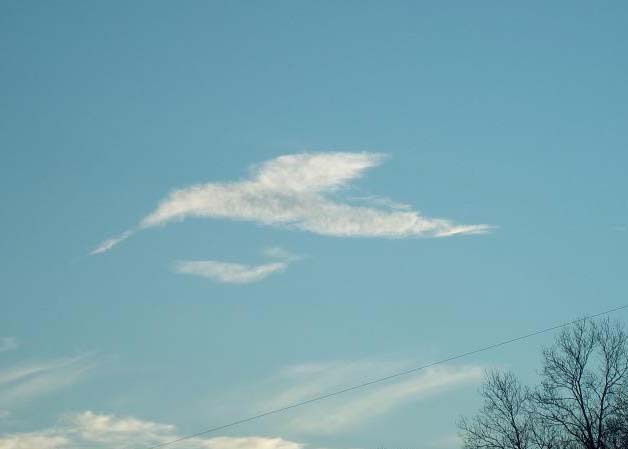

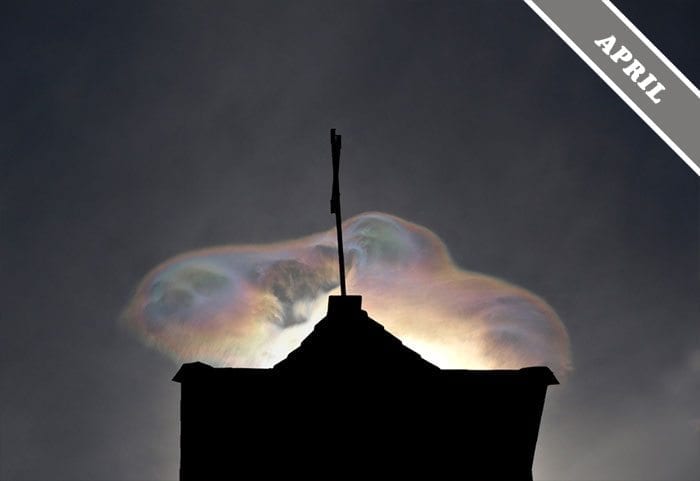
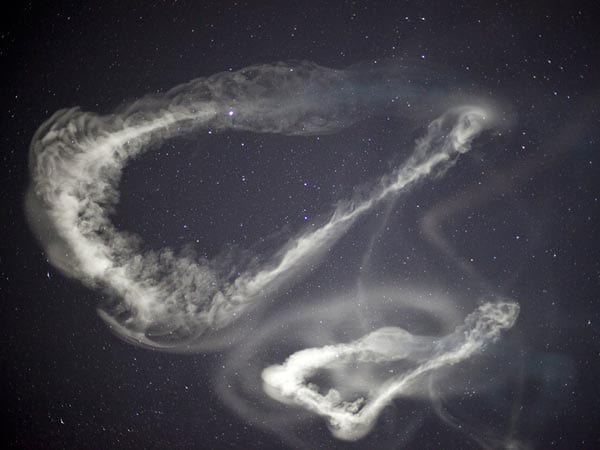
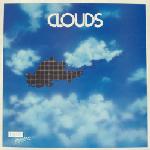






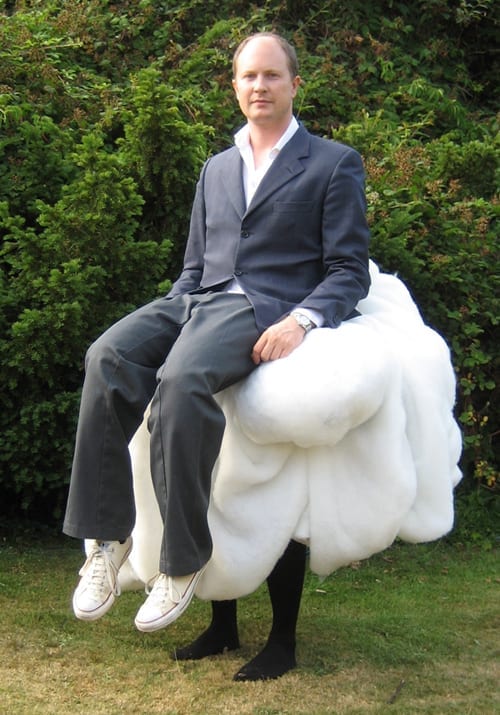


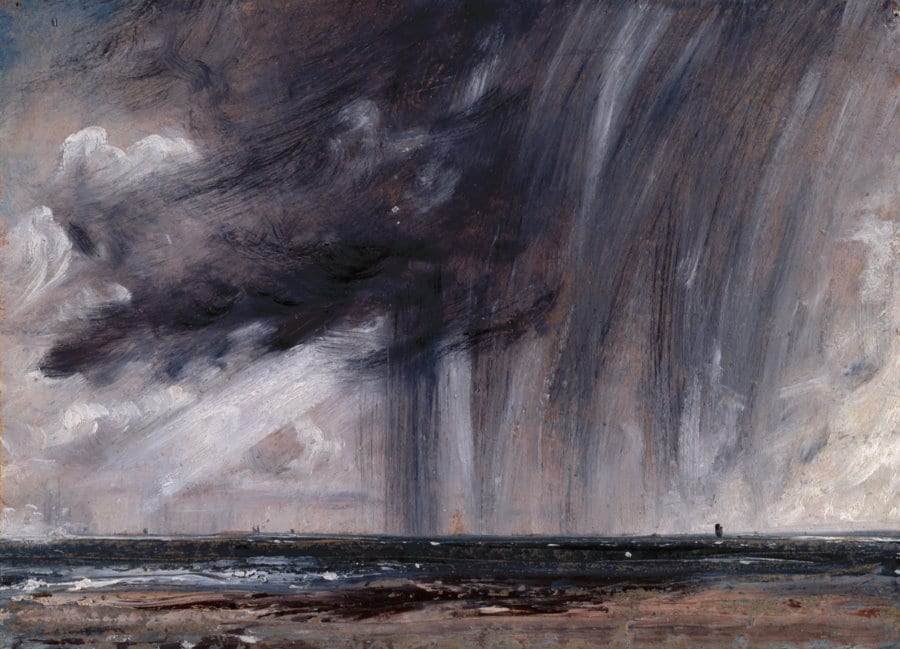
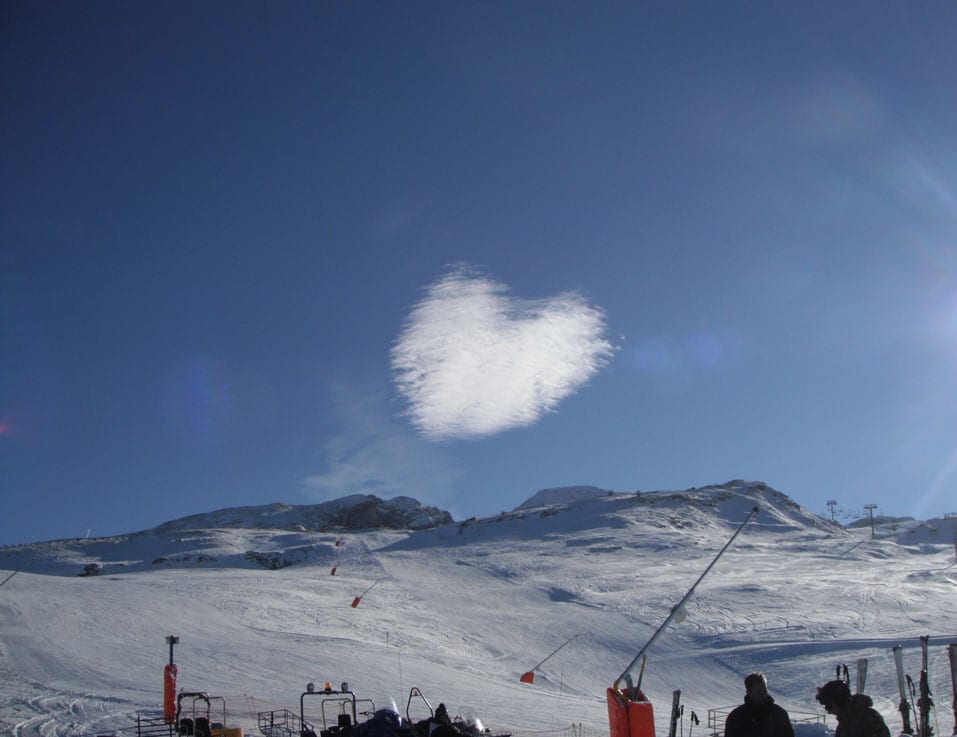
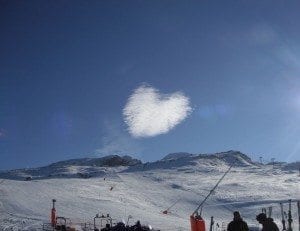



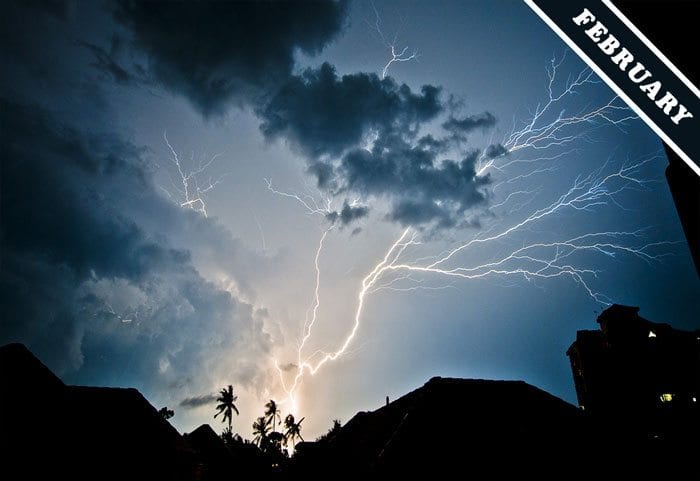
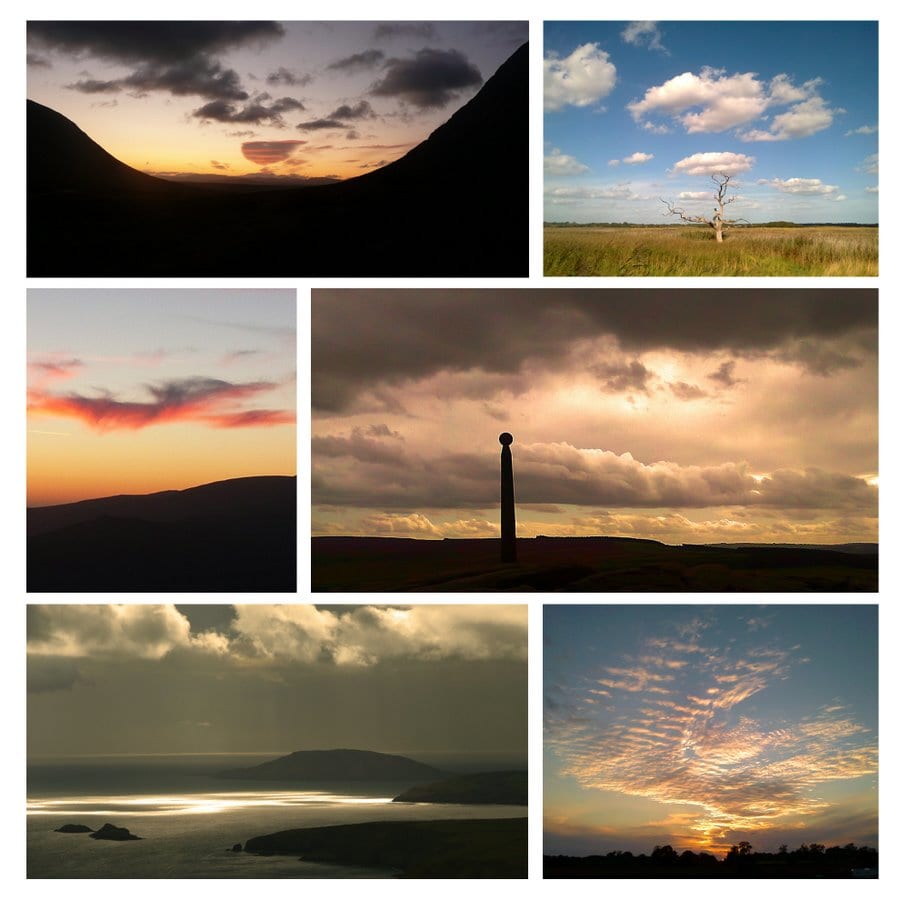
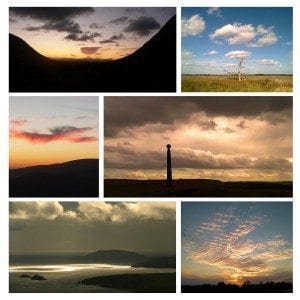
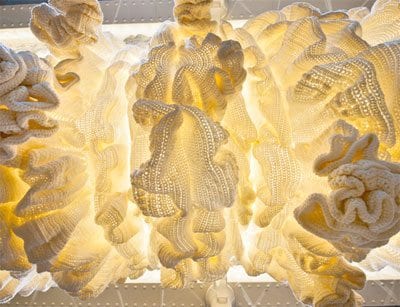
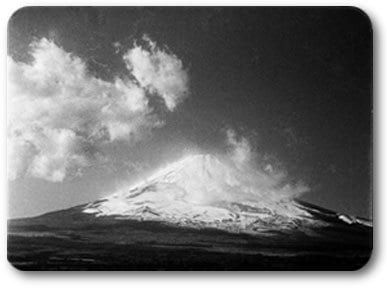
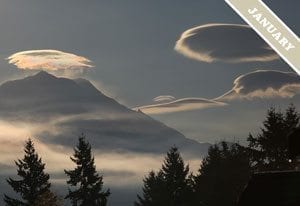
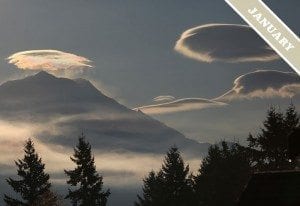
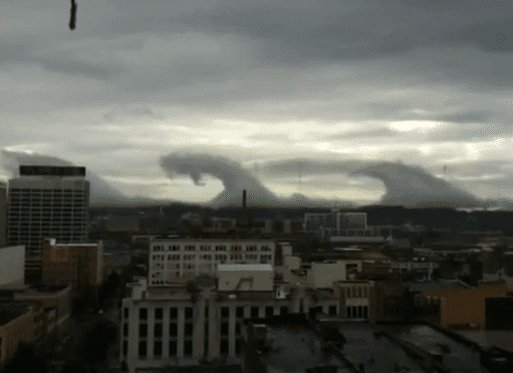



italy.jpg)

